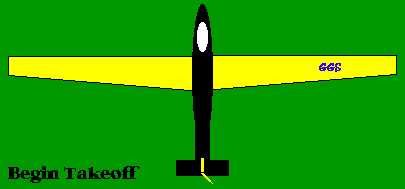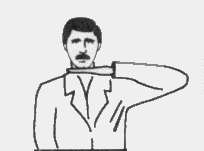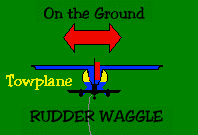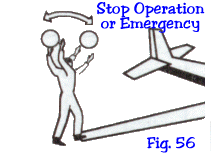Normally, the Standard American Soaring Signals will be used to communicate between the launch crew and tow plane. In some cases, specific local procedures may be in effect. The tow pilot should be thoroughly briefed on any specific local procedures. The tow pilot may be required to observe these signals through the mirror or through an additional signal relay person, positioned safely on the side of the runway adjacent to the tow plane. The ground signals are:

Take Up Slack
The take up slack signal is given by the ground crewmember moving his or her lowered arm from side to side. When you receive this signal, slowly taxi the tow plane forward to take up the slack in the tow line. When all the slack has been taken from the tow line expect to receive the “hold” signal from the ground crew.

Hold
Although similar, there are two distinct, but separate methods to signal hold operations. The Soaring Flight Manual indicates holding the arms straight out as the signal to hold, while the FAA-CT-8080-2B Computerized Testing Supplement For Recreational Pilot and Private Pilot, Figure 56, illustrates the hold signal as arms out with the forearms up. Either signal is satisfactory, just be aware you may see one or the other. Also note the glider wing is on the ground. This is also used to reinforce the hold decision. It is important that a proper briefing be conducted to identify the signals being used.

Pilot Ready, Wings Level
When the glider pilot is ready for takeoff, a thumbs up signal is given and the wing runner will level the wing to the takeoff position.


Begin Takeoff
The glider pilot waggles the rudder with the wings level and the wing runner signals with a circular motion of the arm.
When ready for takeoff, the tow pilot should broadcast on the CTAF that a glider launch is about to be initiated. Example “Tallasee traffic, N12345 taking off runway 33, glider in tow, Tallasee.”
Remember, FAR 91.309 requires that before conducting towing operations within Class B, C, D, or E airspace designated for an airport, or before making each towing flight within such controlled airspace if required by ATC, the PIC must notify the control tower. If a control tower does not exist or is not in operation, the PIC must notify the FAA flight service station serving that controlled airspace before conducting any towing operations.

Stop Engine / Release Towline
This signal is given by moving a hand back and forth across the throat.

Towplane Ready
Prior to take off carefully look at the glider to ensure the glider dive brakes are closed and no one is standing in front of the wings or so close to the launch path to create a hazard.
(Note: Some high performance gliders may make their initial takeoff roll with spoilers open. Know your gliders and if in doubt don’t be ashamed to question the glider pilot. Better to be a bit embarrassed than to end up in the trees at the end of the runway.)
Additionally, the tow pilot should ensure that the traffic pattern is clear of aircraft. Once assured that the glider is ready and the departure path is clear, the ready for takeoff signal may be given with a waggle of the towplane rudder.


Stop Operation or Emergency
Once again, there are two ways to signal “Stop Operation” or “Emergency”. The Soaring Flight Manual shows the signal as “the waggling of arms back and forth above the head swiftly.” While the FAA’s Figure 56 shows a more waving motion of arms above the head. Again, so similar that when you see them you should have no trouble getting the stop or emergency message. Also note that the glider’s wing is on the ground, another signal that the glider is not ready to launch.


